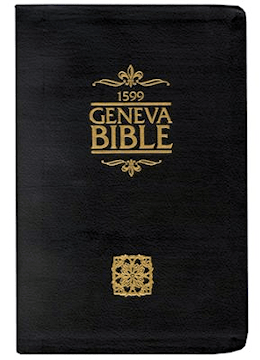Textus Receptus Bibles
Geneva Bible 1560/1599
| 27:1 | Iotham was fiue and twentie yere olde when he began to reigne, and reigned sixteene yeere in Ierusalem, and his mothers name was Ierushah the daughter of Zadok. |
| 27:2 | And hee did vprightly in the sight of the Lord according to all that his father Vzziah did, saue that hee entred not into the Temple of the Lord, and the people did yet corrupt their wayes. |
| 27:3 | He buylt the hie gate of the house of the Lord, and he buylt very much on the wall of the castle. |
| 27:4 | Moreouer hee buylt cities in the mountaines of Iudah, and in the forests he buylt palaces and towres. |
| 27:5 | And he fought with the King of the children of Ammon, and preuailed against them. And the children of Ammon gaue him the same yere an hundreth talents of siluer, and ten thousande measures of wheate, and ten thousand of barley: this did the children of Ammon giue him both in the second yeere and the third. |
| 27:6 | So Iotham became mightie because hee directed his way before the Lord his God. |
| 27:7 | Concerning the rest of the acts of Iotham, and all his warres and his wayes, loe, they are written in the booke of the Kings of Israel, and Iudah. |
| 27:8 | He was fiue and twentie yeere olde when he began to reigne, and reigned sixteene yeere in Ierusalem. |
| 27:9 | And Iotham slept with his fathers, and they buryed him in the citie of Dauid: and Ahaz his sonne reigned in his stead. |

Geneva Bible 1560/1599
The Geneva Bible is one of the most influential and historically significant translations of the Bible into English, preceding the King James translation by 51 years. It was the primary Bible of 16th century Protestantism and was the Bible used by William Shakespeare, Oliver Cromwell, John Knox, John Donne, and John Bunyan. The language of the Geneva Bible was more forceful and vigorous and because of this, most readers strongly preferred this version at the time.
The Geneva Bible was produced by a group of English scholars who, fleeing from the reign of Queen Mary, had found refuge in Switzerland. During the reign of Queen Mary, no Bibles were printed in England, the English Bible was no longer used in churches and English Bibles already in churches were removed and burned. Mary was determined to return Britain to Roman Catholicism.
The first English Protestant to die during Mary's turbulent reign was John Rogers in 1555, who had been the editor of the Matthews Bible. At this time, hundreds of Protestants left England and headed for Geneva, a city which under the leadership of Calvin, had become the intellectual and spiritual capital of European Protestants.
One of these exiles was William Whittingham, a fellow of Christ Church at Oxford University, who had been a diplomat, a courtier, was much traveled and skilled in many languages including Greek and Hebrew. He eventually succeeded John Knox as the minister of the English congregation in Geneva. Whittingham went on to publish the 1560 Geneva Bible.
This version is significant because, it came with a variety of scriptural study guides and aids, which included verse citations that allow the reader to cross-reference one verse with numerous relevant verses in the rest of the Bible, introductions to each book of the Bible that acted to summarize all of the material that each book would cover, maps, tables, woodcut illustrations, indices, as well as other included features, all of which would eventually lead to the reputation of the Geneva Bible as history's very first study Bible.